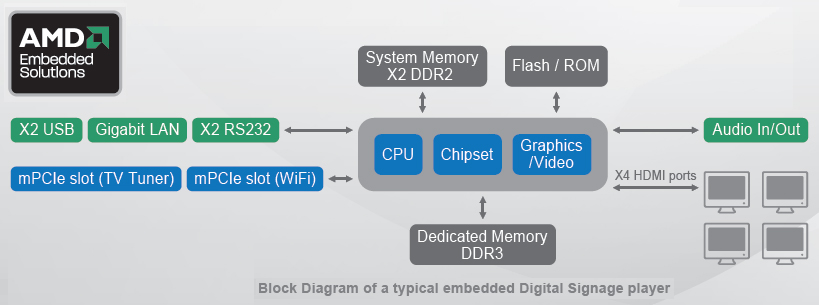- Home
- Symmetry Blog
- Why AMD Embedded - Part 6 of 9 in a Series Presented by Symmetry Electronics and SemiconductorStore.
Why AMD Embedded - Part 6 of 9 in a Series Presented by Symmetry Electronics and SemiconductorStore.com
Wednesday, March 13, 2013
With the ongoing proliferation of internet-based applications and services (including the emergence of Cloud computing), and consumer demand for rich multimedia experiences, many of today’s embedded systems are being used in applications that are highly interactive, highly connected, visually stimulating, and in many cases, highly mobile.
Digital Signage applications are good examples of embedded systems that are becoming ubiquitous. Serving a wide range of needs in markets such as education, retail, and hospitality, they can be found just about everywhere including schools, airports, shopping malls, and hotels.
Digital Signage systems can vary broadly in size and feature set but typically have the following in common:
- A media player capable of playing back pre-recorded and live video (often high definition),flash animations, 2D/3D graphics, text tickers, Microsoft® PowerPoint files, RSS feeds, the latest web-based content, and audio.
- Support for multiple, flexible display configurations and various display connector types such as VGA, LVDS, DVI, and HDMI.
- Networking capabilities including Wi-Fi and LAN: Many devices operate stand-alone but are most often networked to a centralized server that manages content and software updates.
- Hard drive for local storage of media playlists.
 Block diagram of typical embedded Digital Signage player
Block diagram of typical embedded Digital Signage playerLifecycle planning and TCO are closely related in that the lifecycle planning process and decisions made during that process directly affect TCO. While lifecycle planning and TCO calculations are huge topics on their own (and have been written about extensively), we use a simplified example to explain the basic concepts in order to compare TCO between a PC-based solution and an AMD Embedded system solution in a typical digital signage deployment. Some major factors to consider in the lifecycle planning process:
- What kinds of systems are going to be deployed?
- How long is the entire deployment expected to exist and be supported (i.e. “the lifecycle”)?
- How long will each system that is being considered be available and supported?
- Will software need to be updated and how often?
- Will the size of the deployment change over time?
- What are the expected failure rates of the main components of each system?
Once the lifecycle planning process is completed (or at least the major decisions are made), TCO can then be estimated for each system solution being considered. To calculate TCO, the following must be considered:
- Acquisition cost of the primary systems
- Acquisition and carrying cost of additional systems to be kept in inventory
- Energy costs based on power consumed by each system (as determined by the usage model)
- Support costs including technical support, maintenance, warranty, replacement, and repair costs (note that this can become quite complex as multiple hardware and/or software configuration are introduced)
- Cost of downtime due to a failed system being repaired or replaced
AMD Embedded, as shown in our past entries, outperforms PC in every aspect. From performance to price, if you are looking for a solution that will reduce overall TCO and allow resources to move on to the next project, AMD Embedded is the solution.
An example of an embedded application deployment containing a relatively small network of 100 digital signage systems as deployed and supported over a 5 year period will be presented in part 7 of our series.
Symmetry Electronics (and its e-commerce division: SemiconductorStore.com) is an authorized AMD Embedded distributor.